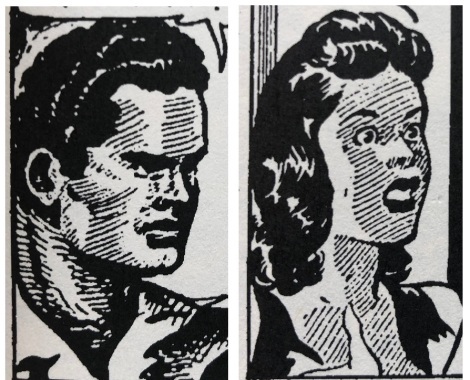The Cover of The Color of Paper
First, a thank you to comics color scholar Guy Lawley. After I repeatedly pestered him about interpreting CMYK dot percentages in Silver and Bronze Age comics panels, he suggested I purchase my own microscope lens attachment for my phone. Which I did:

Here’s one of the first pictures I took with it:

That’s from August 2022, so also evidence that I’ve been working on this project for a while now. The image is a Kirby rendering of Sue Storm, color art probably by Stan Goldsmith, Marvel’s main colorist during the 1960s when it was still the industry norm not to give color credit. I don’t know what issue of Fantastic Four I was playing with. The point was to zoom in enough to highlight the yellow and red dots that combine with the white paper to create a pointillistic impression of White skin.
I also thought it would make a good cover for what was then only a book-in-progess tentatively titled The Color of Paper, about how physical ink-on-paper images communicate the socially constructed concepts of racial categories. But I didn’t want to try to wrestle Marvel for permission. Also, I don’t analyze Fantastic Four anywhere in the book. Though “Invisible Girl” would make an intriguing visual synecdoche for comic book Whiteness, I wanted an image from one of my case studies, and so one that challenged or in some way complicated ethnoracial divisions.
So two later years, with the book fully drafted, I hunted down the microscope lens in my desk drawer and took this photo:

That’s Maggie from Love and Rockets. Or, more precisely, from Mechanics, a color edition of Jaime Hernandez’s “Mechanics” that Fantagraphics re-published in 1985 as a mini-series with color art by Paul Rivoche. I devote a little over 4,000 words comparing the black-and-white and color editions as the first of three subsections of The Color of Paper‘s “Adding Color” chapter. Unlike Hernandez’s own initial and later color art, Rivoche gave the Chicana character darker skin. Which, in contrast to Sue Storm’s microscopic close-up, means larger red and yellow dots and the addition of smaller blue dots. That’s what color, and therefore Color, is in the four-plate printing process that dominated 20th-century comics.
I also like how the extreme close-up captures the physical paper, especially those tiny creases running through the center of the face, and how the warp of the lens throws the top and bottom out of focus. That’s because the face is only a small section of a larger panel:

Which is only a small section of a larger page:

I experimented with a few other zoom-ins, but didn’t like them as much:

When I shared photos with my editor as possible cover art ideas, she liked them, but given time constraints and no cover art budget, she suggested we go with the second option I sent her:

That’s an image I made through a truly idiosyncratic process in MS Paint. I selected it because it leaves so much of the interior area of the face unmarked and so as the color of the page, which is conceptually different but physically identical to the unmarked white areas outside the face. The face itself also resists (my) interpretation: I’m not sure of the figure’s age, gender, or race/ethnicity. That might sound odd since I’m the artist, but the image-making process was emergent, meaning I had no endpoint in mind when I started and only partial control as the image evolved (a process I detailed in a 2022 post and later sharpened into multiple series).
Since a lot of The Color of Paper is about color processes (mostly CMYK vs. Photoshop), I reentered the image and substituted the original black pixels with overlapping red and yellow ones on the white background:

The process evokes CMYK, but doesn’t produce the effect of Sue Storm’s “White” skin. Still, one of those could have made a good cover, and no small part of my ego would have relished having my own art on the cover of my book. That was one of my not-so-secret pleasures for The Comics Form:


And yet, I really think the microscopic Maggie photo is better, both for visual appeal and conceptually.
So I wrote Fantagraphics and explained that the book was coming out from an academic press and had no cover art budget. Could I use the image anyway? To my surprise and delight, they responded with an immediate yes — literally the same day. I’ve had to get permissions from several comics publishers for previous books, especially for the anthology section of Creating Comics, and I can report that responsiveness and helpfulness varies radically. Yet Fantagraphics is consistently at the happy top of both scales. They emailed me a contract charging $0, and even offered to forward a high-res image of the page — which I declined, since the microscopic creases were part of the appeal.
So that’s how I undermined my own burgeoning cover artist career.
But then when I was reading the press’s author photo guidelines, I realized that a drawing of myself would thematically suit the book better, placing my image in visual conversation with the many images of faces within the text. So I asked my editor what she thought of this:

She responded with an immediate and enthusiastic yes. Like the one that won’t appear on the cover of The Color of Paper, this is another of my idiosyncratic MS Paint images, though not emergent this time. It’s a self-portrait slowly rendered through a digital woodcut process (detailed in a post last semester).
I’m not as skilled as Jay Jackson or Yvan Alagbé, but the self-portrait now speaks back to their and other black-and-white images I analyze in my “Seeing Skin” chapter. The use or non-use of hatching is especially interesting in how it does or doesn’t imply skin color and/or shadow.


If my self-portrait were CMYK-colored, the heavily hatched interior areas of my face would have the same red and yellow dots as Sue Storm’s “White” skin.
I’ve since done a couple more self-portraits that are more accurate:


But I prefer the distortions of the earlier more woodcut-like one.
The press also asked me for further thoughts about the cover design, so I made and sent this rudimentary mock-up, inspired by The Comics Form cover:

I’m happy to say that designer Alexa Love did way way better:

I can’t wait to hold a physical copy in my hands. The book will be out from Ohio State University Press in February 2026.
Chris Gavaler's Blog
- Chris Gavaler's profile
- 3 followers



